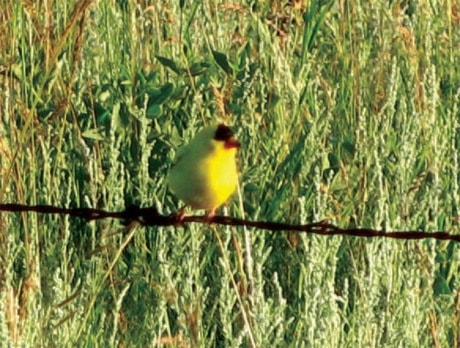BRENDA SCHROEDER
Independent Contributor
When you visit Sunrise Farm, northeast of Strome, Alberta, and tour around with Don Ruzicka, it doesn’t take you long to notice the multitude of bird houses around the farm, and if you don’t notice - he is likely to point them out to you.
While Ruzicka has been planting trees in order to rebuild the habitats that were destroyed through years of clearing out brush in order to remove the obstacles to seeding, spraying and harvesting - he’s also been putting up birdhouses as a more immediate way to attract the songbirds that once called his farm home.
The aesthetic value of bluebirds are what most people grasp when they think of this and they appreciate Ruzicka’s efforts to make his farm a more enjoyable place for everyone - the humans and the birds.
But then he smiles and lets you know what he is really investing in when he is putting up birdhouses: he’s investing in his grasshopper control system.
In 2002, when the grasshoppers were so thick it sometimes looked like the roads were rivers of insects, this system was put to the test. Along with plenty of fat, happy song birds - the Ruzicka farm experienced much less grasshopper damage.
What Ruzicka is doing is putting into practice what the agriculture researchers are calling ‘conservation biological control.’
By conserving (and re-building) the habitat for natural predators of pests - a natural system of biological control is kept in place.
It must be recognized that this is a different approach than what we are used to hearing about when biological pest control is used. Classical biological control introduces natural enemies for specific pests into an ecosystem where they did not originate or where they are not present.
It is a reaction to an infestation and while it may have long-lasting effects, still requires introducing a new species into an ecosystem in order to control and maintain control over an outbreak. The shift in focus that conservation biological control takes is that it is more proactive and preemptive.
The intent is to retain and build habitats for natural predators who are already within the ecosystems so that their population is in place as part of pest control - they act as a balance in the system to keep pest populations low therefore avoiding outbreaks that become problematic to producers.
If Ruzicka had waited until the drought came along and the grasshopper population spiked to build his birdhouses - the bird populations would not have been able to establish themselves in time. By maintaining the habitat of songbirds during times when their services were not necessary for him – he was able to ensure they were in place to work for him when they were really needed. Inside Agriculture and Agri-Food Canada, more attention is being paid to this way of working. There are researchers here in Alberta who are currently measuring the effectiveness and impacts of approaches like Ruzicka’s.
This is the kind of work that organic farmers like Don Ruzicka take on. Being organic doesn’t mean that they ignore the pests and weeds but that they find different ways to control them. Ways that reduce the amount of chemicals put out into the environment as well as decreasing the costs of inputs required on their farm operation.
When asked about his approach to pest control, Ruzicka quotes E.O. Wilson who writes “the more species that you have in an ecosystem, the more resilient it is to drought and other environmental stresses.”
